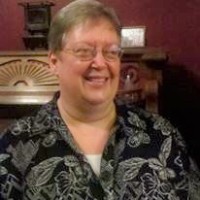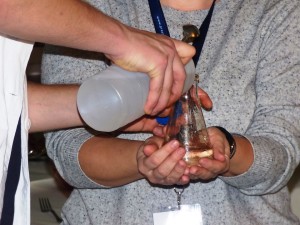In my search for stories that exemplify The Goodness Principle I came across the following narrative penned by a nurse, Sara Conkle. It originally ran in Pulse – voices from the heart of medicine. As I read the story, I’m pretty sure that my heart skipped a beat. I’ve never read anything quite like this before and once you read it I think you will agree. Rather than try to summarize the events of this story I thought it best to reprint it as Sara Conkle wrote it, with her permission. And while it definitely has an element of sadness to it there is also an element of goodness here, how what happened compelled Sara to change her professional direction and become a hospice nurse.
Reprinted with permission from Sara Conkle and Pulse – voices from the heart of medicine. Pulsevoices.org

By Sara Conkle
The woman lying on the transport cot in the examination room was terrified. I could see it plainly in her eyes, but there was no time to stop and comfort her.
I was a young, recently graduated nurse in a busy urban emergency room, struggling to keep up with its daily array of shootings, stabbings and crises. ER nurses hustled. We dealt with life and death, and we did it quickly. That may be why I paid so little attention to the pain and fear in the woman’s eyes.
I asked her to get onto the examination table and duly recorded the facts: her last menstrual period had taken place several months before; her bleeding and cramping had started earlier this evening.
Tossing her a gown, I told her to put it on and get back onto the cot so that she could rest until the doctor could come and examine her. Then I left, forgetting about her the moment the door closed behind me.
Finally, after who knows how long, a doctor was ready to see her. He and I walked back to the room where she waited. I imagine that she must have felt cold and lonely, lying there covered only by her skimpy gown and little white sheet.
I helped her off the cot and onto the table, and then stood by, ready to assist the doctor as needed. When he silently handed me a closed specimen container, I labeled it and deposited it on the shelf with the others.
The patient went back to the cot and her skimpy sheet. Her chart went back onto the rack. I wheeled her out of the examining room and into the noise and chaos of the ER. I pulled the curtain around her and paged the ob/gyn resident.
He arrived soon after. I handed him the patient’s chart and saw his eyes widen slightly, as if he recognized the name. I expected him to tell me to take her back to the examination room.
“Can you please bring me the specimen?” he asked quietly.
Luckily the lab tech had not yet made her rounds, so I was able to retrieve it from the shelf. I handed the container to him and watched curiously as he slowly pried open the lid. He gazed into the container, and then reached in with a gloved hand.
Puzzled, I moved closer. In his hand I saw a tiny form, so small that it fit easily in the palm of his hand. Little arms, little legs and hands and feet and the brightest blue eyes.

I staggered back, shocked. I’d had no idea that I had tossed a perfectly formed fetus into a pile of bodily fluids. When the doctor stepped behind the curtain, I followed. The woman’s frightened, sad eyes darted from his face to his large hand gently cradling the tiny form.
She drew back, then leaned forward slightly. He held out his hand.
“Here is your baby. Look how beautiful. It’s okay–you can look.” She nodded, her eyes locked onto his hand.
“You can touch. It’s okay. This is your baby.”
Her hand reached out shakily. With one finger, she gently stroked the tiny form.
“You can hold your baby,” he said. Again their eyes met, then her fingers cupped beneath his, and he gently slid the small body into the mother’s waiting hands.
I stepped outside the curtain and stood there, tears rolling down my cheeks. In that moment, a very young nurse learned the importance of being able to say goodbye. The feeling was visceral–a lesson that no book or lecture could ever have taught me. As the young mother had said goodbye to her infant, I realized, something had changed inside her heart. Something had changed in me, too.
I began to understand just how powerful are the forces that bind us to one another. And I began to see that, even amid the chaos of an ER, a single moment can help to ease the pain and begin the healing for a mourning heart.
A single moment can also change the path of a caregiver.
Many years after witnessing that young mother’s grief, I heard the phrase “lean into the pain.” Instantly I recalled her two physicians. One, dealing with the chaos of the emergency room, performed his duties, snapped the lid on a specimen container and walked out of the room. The other literally leaned in, a precious form in his hand. Despite how differently each physician had responded, I had come to know them both as caring, competent and respected doctors, but the resident’s words and actions stayed with me.
A young woman’s dream died that night–but a seed was planted in me.
I spent a decade in the ER, then another decade as a home-care nurse. I listened to stories told in living rooms, kitchens and bedrooms. As I became more attuned to the emotions beneath the stories, I began to hear the echo of the resident’s words. I found myself repeating variations of the theme: “It’s okay to look…it’s okay to touch…it’s okay to mourn…it is good to say goodbye.”
The resident had recognized the young woman’s pain and had stood in silence, giving a mother space to acknowledge her deep feelings. I remembered–and I learned that a quiet presence can be a powerful force for healing.
Out of that seed planted, out of that learning, a hospice nurse was born.
About the author:
A nurse for thirty-five years, Sara Conkle has spent sixteen of those years as a community-health nurse practitioner focused on end-of-life care, most recently in a home palliative-care program. She is married, with two sons and two granddaughters. “They’re my chief focus and joy when I’m not working. A long-dormant need to write surfaced about thirteen years ago–sparked, I’m sure, by the nature of my work. I benefited by much encouragement from my husband, my family and our hospice medical director. I’m very interested in writing as a reflective practice, enjoy my writing group immensely and love to read and walk in the woods.” This is her first story for Pulse; other published works include excerpts in 12 Great Choices Smart Moms Make (Harvest House Publishers) and in a devotional, Macchiato Moments. “A completed novel rests serenely on the shelf of my study; perhaps someday I will revisit it.”